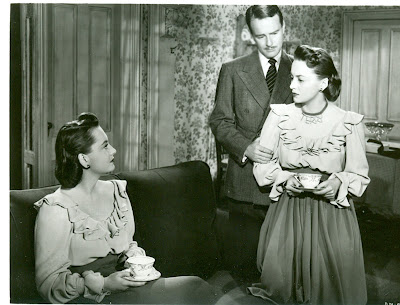Four films from the classic era of film noir, from four celebrated directors of the period (Robert Siodmak, Fritz Lang, Abraham Polonsky and Joseph H Lewis), have been bundled together by Arrow in this dual format box set. Here's what's included:
The Dark Mirror (1946)
A doctor is found stabbed to death next to a smashed mirror. The evidence all points to Teresa Collins (Olivia de Havilland), but she has a cast iron alibi. Or does she? Does the alibi actually belong to her twin sister Ruth (Olivia de Havilland again). Psychologist Dr Scott Elliott (Lew Ayres who later disappeared beneath the ice in 1978's DAMIEN OMEN II) specialises in studying twins and, using all the best daft dime store giallo analytical techniques and theories eventually solves the mystery.
While not as good as director Robert Siodmak's THE SPIRAL STAIRCASE (1945) or THE KILLERS (1946) which I reviewed here, THE DARK MIRROR is still an entertaining psycho-noir that keeps you guessing up to the end. Special features include a commentary track and a detailed analysis of the film from Noah Isenberg.
Secret Beyond the Door (1947)
Celia (Joan Bennett) marries Mark (Michael Redgrave), an architect with a penchant for adding 'murder rooms' to his country estate. But one of those rooms is constantly locked. Oh, and Mark's first wife, Elinor, might just have died under mysterious circumstances. There is rumour that Mark has now exhausted his dead wife's fortune. Celia just happens to be rich. Could she be next?
For a thriller SECRET BEYOND THE DOOR is sadly lacking in the thrill department, despite composer Miklos Rosza trying his hardest to increase the dramatic tension. Director Fritz Lang does offer us some fantastic visual compositions, though, so it's not a dead loss, but I couldn't help but feel that this would have worked better as a B picture with lesser actors but a lot more oomph.
Extras include a commentary track from Alan K Rode, a talking head piece from author Barry Keith Grant, a visual essay on Fritz Lang's style by David Cairns, a Bluebeard radio play, image gallery, and a trailer for the Fritz Lang film HANGMEN ALSO DIE (1943).
Force of Evil (1948)
Mob lawyer Joe (John Garfield) becomes involved in New York's numbers racket, with a plan to bring together all those who run them. One of them is his brother Leo (Thomas Gomez) who doesn't want to be a part of it. The others engineer a fix (the number 776 on the fourth of July) so Joe has to pay out a fortune and can't. Joe tries to get his brother a job with the mob but Leo refuses, and it all ends in tragedy.
Probably the least of the movies on here, FORCE OF EVIL is still thought of highly, with the theory that left wing director Abraham Polonsky may have used the numbers game as a symbol of capitalism as a whole (he was blacklisted shortly afterwards.) He gave DP George Barnes a book of Edward Hopper paintings to help suggest how he wanted the film to look and, as in the other movies in this set, there are some truly awe-inspiring uses of light and dark.
Extras include a commentary track by Glenn Kenny and Farran Smith Neame, and a visual essay on the film by Frank Krutnik who also provides commentary on specific themes.
The Big Combo (1955)
Arguably the best is last. Joseph Lewis' mid-fifties noir boasts a great cast of familiar faces (Cornel Wilde, Robert Conte, Lee Marvin, Brian Donlevy, Earl Holliman and John Hoyt amongst others) and is quite possibly the most stylish of the lot.
Lieutenant Diamond (Wilde) is obsessed with bringing down crime boss Mr Brown (Conte). Brown is keen to bump off Diamond. Caught in the crossfire are Brown's girlfriend (Jean Wallace), Diamond's girlfriend (Helene Stanton), and Brown's wife (Helen Walker). I won't say any more about the plot because it would spoil it, but there's a creative torture scene with a hearing aid and a great bit at a classical music concert where the piano embellishes the drama going on in one of the boxes.
Extras include a commentary track from Eddie Muller, a visual essay on the director, an introduction by Geoff Andrew and the screenplay as a BD-DVD ROM.
You also get a hardback book as part of the set with new writing on all the films, production stories, contemporary reviews and more. A great crash course if you're unfamiliar with the genre, and plugging some valuable gaps in your collection if you're after them all on Blu-ray.
FOUR FILM NOIR CLASSICS is out on Arrow in a dual format set on Monday 20th November 2017












No comments:
Post a Comment